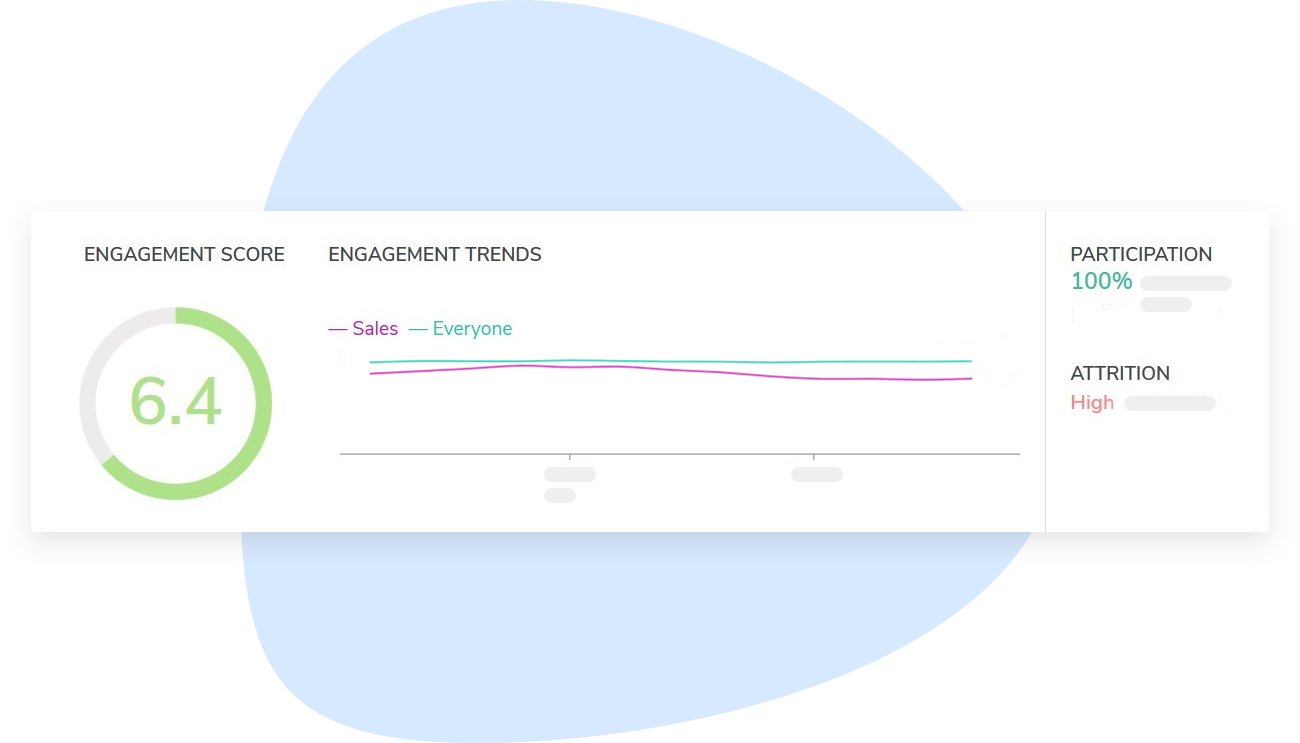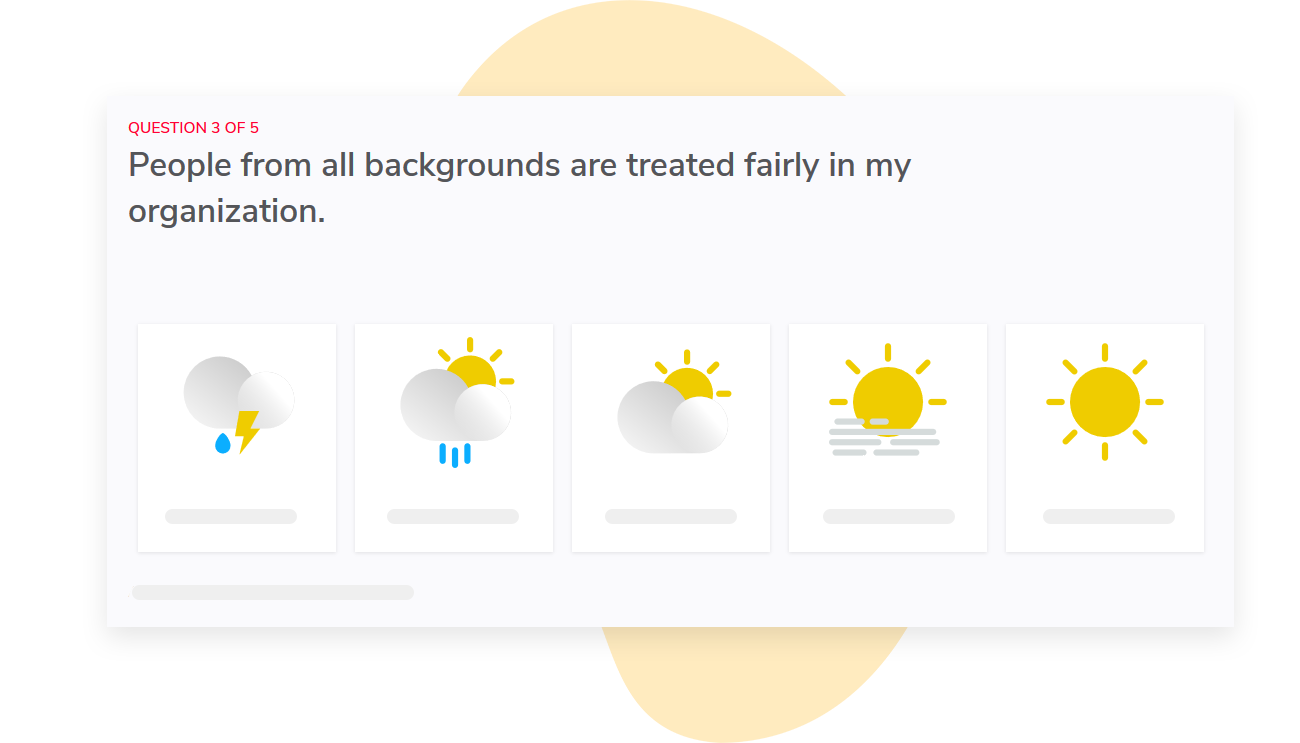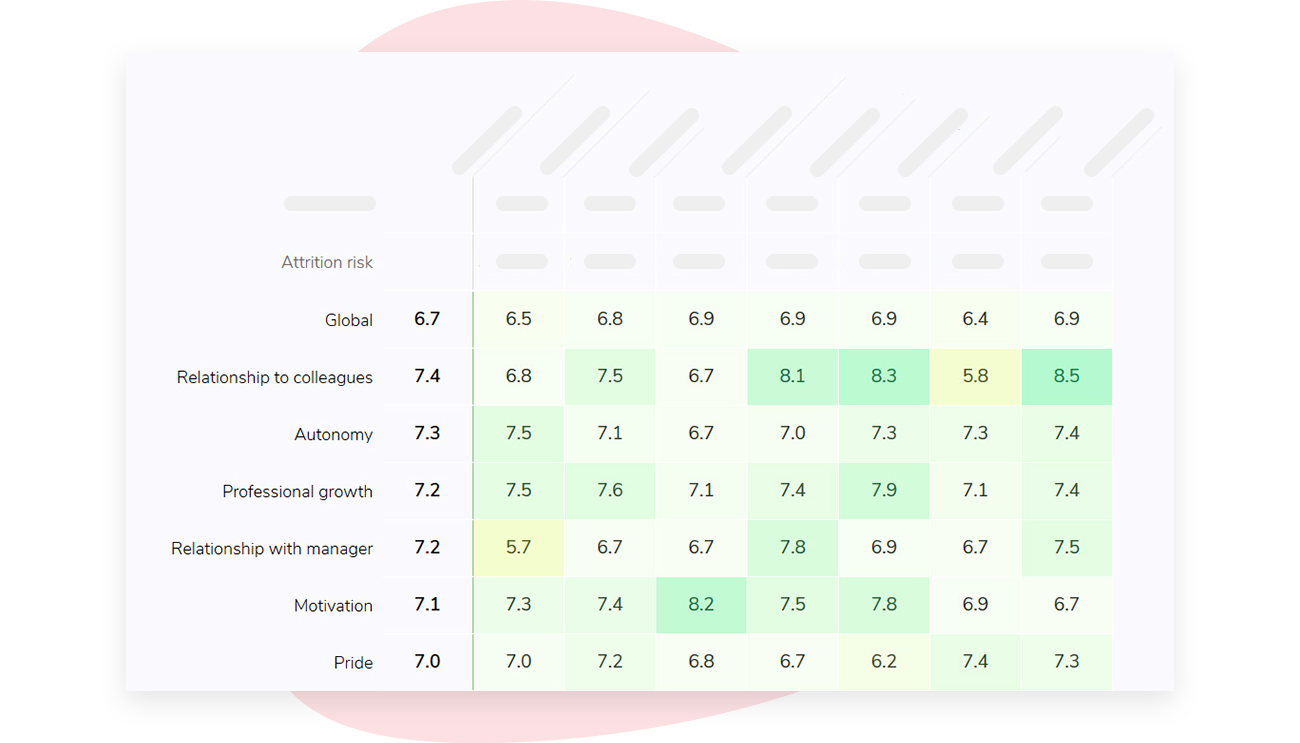Employee survey tool
Get accurate, and frequent employee feedback with Sparkbay's employee survey tool
Engagement is what drives companies. Sparkbay monitors employee engagement, alerts you of any disengagement signs, and helps you improve with data-driven recommendations.
How our employee survey tool improves employee engagement
Real-time insight
Sparkbay collects feedback from every employee in your organization.
Unlike traditional surveys, Sparkbay’s pulse surveys take just minutes to complete and deliver data instantly.

Ask the right questions
With its intelligent question assignment, Sparkbay delivers the right question to the right person at the right time. That way, you'll uncover disengagement patterns as soon as they arise.

Make data-driven decision
Making the right decisions is essential to your success.
Sparkbay’s interactive dashboards will give your leaders actionable insights for every employee segment: direct manager, department, office, tenure, title, demography and more.

Act on feedback: close the loop
Collecting employee feedback is only the beginning.
Sparkbay turns your managers into agents of change within their teams, with actionable personalized recommendations.

Improve employee engagement
See in actionEmployee survey tool FAQ
What is an employee survey tool?
An employee survey tool is a software or platform that organizations use to gather feedback and opinions from their employees. The surveys can cover various topics such as job satisfaction, company culture, work environment, management, benefits, and career development. The results of the surveys are used to improve the workplace and increase employee engagement and satisfaction.
What do employee survey tools measure?
Employee survey tools measure a variety of factors related to the workplace and employee experience, including:
- Job Satisfaction: Employees are asked about their level of satisfaction with their current role, responsibilities, and overall work environment.
- Company Culture: Surveys assess employees' perceptions of the organization's values, ethics, and overall workplace environment.
- Work Environment: Feedback is collected on aspects such as physical work conditions, availability of resources and equipment, and opportunities for growth and development.
- Management: Surveys evaluate employees' opinions of their immediate supervisors and the effectiveness of leadership within the organization.
- Benefits and Perks: Employee perceptions of the benefits and perks offered by the organization are measured to determine their level of satisfaction.
- Career Development: Surveys assess employees' perception of the opportunities for growth and development within the organization.
The results of employee surveys can help organizations identify areas for improvement and inform decisions that impact the workplace and employee experience.
Why are employee surveys important?
Employee surveys are important for several reasons:
- Improving Employee Satisfaction: Surveys help organizations understand the level of employee satisfaction with various aspects of the workplace, allowing them to make improvements and increase employee engagement.
- Identifying Issues: Surveys can uncover issues that employees are facing, such as a lack of resources or challenging work conditions, which can then be addressed by management.
- Measuring Employee Engagement: Surveys provide a measure of employee engagement and can help organizations understand the level of investment employees have in their work and the company.
- Informing Decision Making: The results of employee surveys can inform important business decisions such as changes to company policies, benefits packages, or the allocation of resources.
- Building a Positive Workplace Culture: Employee surveys provide a forum for employees to voice their opinions and feelings about the workplace, promoting open communication and a positive company culture.
- Improving Retention: By regularly assessing employee satisfaction and engagement, organizations can address issues before they lead to turnover and retain top talent.
Overall, employee surveys are an important tool for organizations to gather feedback, improve the workplace, and increase employee satisfaction and engagement.
What are the benefits of using an engagement survey vendor?
There are several benefits to using an engagement survey vendor:
- Expertise: Engagement survey vendors have expertise in designing, administering, and analyzing employee surveys. They can provide customized survey solutions to meet the specific needs of the organization.
- Time-saving: Engagement survey vendors can handle all aspects of the survey process, from designing the questionnaire to analyzing the results, freeing up time for organizations to focus on other important tasks.
- Objectivity: Using an engagement survey vendor can provide a level of objectivity that is difficult to achieve when conducting surveys internally. Vendors are less likely to be biased and can ensure that the survey results are accurate and reliable.
- Customized Reporting: Engagement survey vendors can provide customized reporting and data analysis to help organizations understand the results and identify areas for improvement.
- Confidentiality: Engagement survey vendors can ensure that the survey results are kept confidential, promoting honesty and openness in the responses.
- Best Practices: Engagement survey vendors can provide best practices and recommendations based on their experience with other organizations and industries.
Overall, using an engagement survey vendor can help organizations gather reliable, objective, and actionable data that can inform important business decisions and drive improvements in the workplace.
How do employee survey tools work?
Employee survey tools typically work as follows:
- Design: The vendor or organization designs the survey questionnaire to measure various aspects of the workplace and employee experience. The questions can be multiple-choice, open-ended, or a combination of both.
- Administration: The survey is typically administered online, allowing employees to participate anonymously and at their own pace. The survey may be distributed via email or a unique URL, and responses are collected and stored in a secure database.
- Data Collection: Employee responses are collected and stored in a database where the data can be analyzed and aggregated. The data can be segmented by department, location, or other criteria to identify trends and patterns.
- Data Analysis: The vendor or organization analyzes the data to identify trends and patterns in the responses. They may use statistical methods, such as regression analysis, to identify relationships between different variables.
- Reporting: The results of the survey are reported back to the organization in the form of a report or dashboard. The report may include summary statistics, charts, and graphs that illustrate the results.
- Action Planning: The results of the survey can be used to inform important business decisions and drive improvements in the workplace. The organization may develop an action plan to address areas of concern identified by the survey results.
Overall, employee survey tools work by collecting, analyzing, and reporting on the opinions and experiences of employees in the workplace. The results can be used to improve the workplace and increase employee satisfaction and engagement.
How often should I be sending employee surveys?
The frequency of employee surveys can vary depending on the organization's goals and objectives. Here are a few factors to consider:
- How frequently the metrics you are measuring are likely to fluctuate
- How fast you can absorb and analyze results
- How fast you can implement action plans
- How often are other organizational metrics reported?
Ultimately, the frequency of employee engagement surveys will depend on the specific needs of the organization and its employees. It's important to consider the workload and resources required to conduct the surveys, as well as the goals and objectives of the organization. Regular engagement surveys can help organizations stay informed about employee experiences and identify areas for improvement, but it's also important to give employees time to see the impact of any changes made in response to previous surveys.
Does every single employee need to be included in the employee engagement survey?
Not every single employee needs to be included in an employee engagement survey. The scope of the survey will depend on the goals and objectives of the organization. Here are a few factors to consider:
- Representativeness: Organizations may want to ensure that the survey includes a representative sample of employees across different departments, locations, and job functions.
- Response Rate: The response rate of the survey can impact the validity and reliability of the results. To ensure a high response rate, organizations may want to include as many employees as possible in the survey.
- Resources: Conducting a comprehensive employee engagement survey can be resource-intensive, and organizations may want to prioritize including employees who will provide the most valuable feedback.
Ultimately, the decision of which employees to include in an employee engagement survey will depend on the specific needs and goals of the organization. It's important to strike a balance between representativeness, response rate, confidentiality, and resources when determining the scope of the survey.
